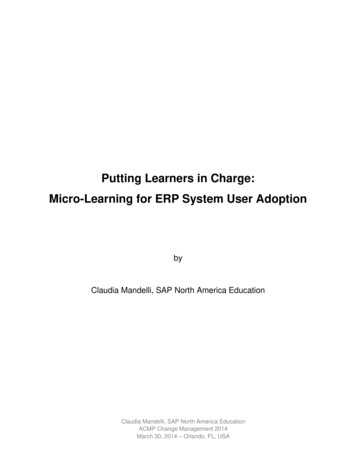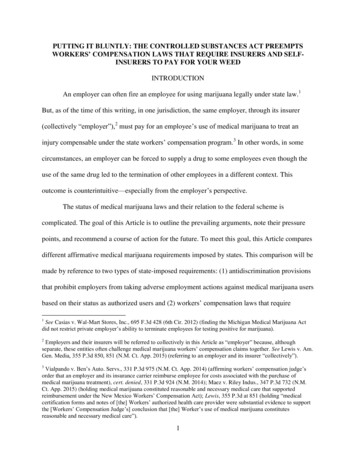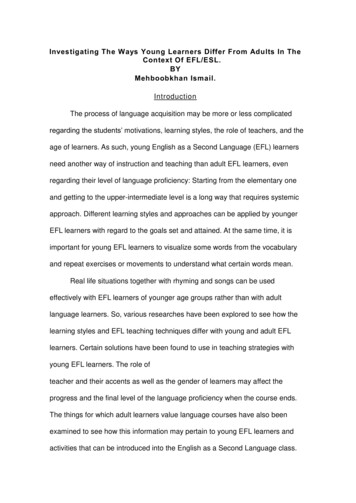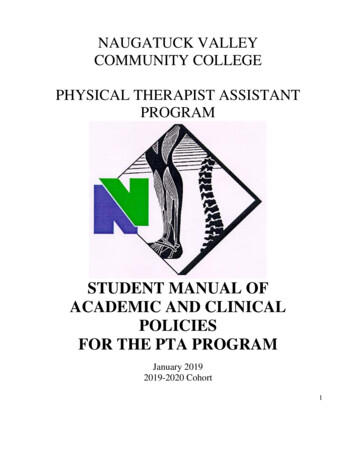
Transcription
Putting Learners in Charge:Micro-Learning for ERP System User AdoptionbyClaudia Mandelli, SAP North America EducationClaudia Mandelli, SAP North America EducationACMP Change Management 2014March 30, 2014 – Orlando, FL, USA
Executive OverviewMicro-learning is an extremely powerful methodfor learning how to use a new system. Yet,companies are struggling to implement it.Successful micro-learning relies on puttingindividuals in charge of their learning, andsupporting them with appropriate technologyand instructional design.“Micro-learning” is a paradigm rapidly growingin relevance and importance among changemanagement and learning professionals.Most of us have experienced examples of“microlearning”. For example, several mobileapplications have short, elegant usage tip sheetpresented directly on the screen, which explainin simple steps how to activate a newfunctionality. We immediately recognize“microlearning” opportunities surrounding us forthe brief, appealing and rapidly consumedcontent, delivered with the right technology atthe moment of need.Micro-learning is aligned with major trendsshaping technology innovation and learning,related to the widespread usage of mobility andthe entrance of new generations in theworkforce.The purpose of this paper is to discuss thevalue and applicability of micro-learning in thecontext of learning a new ERP system. First, we will define micro-learning andprovide observations on effective microlearning content Second, we will discuss the challengesencountered when attempting to deploymicro-learning. Third, we’ll experience a learning journeyfrom the perspective of an individual, “Joethe Engineer” Fourth, we will review the technologyconsiderations behind micro-learning Fifth, we’ll discuss instructional designprinciples that fit the microlearningparadigm. And last, we’ll review how companies candesign an effective microlearning approach.What is Micro-learning?Micro-learning consists of small, quicklyconsumed information delivered repeatedly togenerate permanent learning. Micro-learningbreaks information into small, engaging bits thatare easy to consume.Learning content provided in this modality hasthree main characteristics:1. Informative and engaging: Targeted,short, visually appealing messages arecritical. Communication format will focus onshort text, videos, and links. The goal is tocreate fun, engaging experiences that invitelearning of new functionality or process.2. Timely consumed: Short messages,repeated multiple times, are the key toeffective learning and a cornerstoneprinciple of micro-learning.3. Delivered anywhere, anytime: Content isprepared to work on both mobile and nonmobile devices to reach a broad, oftenmobile audience. The right combination ofsynchronous and a-synchronous learning iscalibrated for your unique situation.Claudia Mandelli, SAP North America EducationACMP Change Management 2014March 30, 2014 – Orlando, FL, USA
Micro-learning Business ValueMicro-learning is an incredibly powerful tool toaugment traditional learning such as InstructorLed Training (ILT) or eLearning Programs.Learning organizations and professionals arepreparing to take advantage of informallearning. Some of the most frequent drivers formicro-learning are associated with: Efficiently sustaining competency over time.For example, learners who are alreadyusing a new system prefer to learn updatesdirectly when they are in the system, ratherthan attending formal training.Overcoming resistance to traditionaltraining. This is especially true in relationwith the workforce generational shift. By2020, 50% of the workers will be generationY or millennials. These individuals areactive learners and prefer to learn withsnippets of information presented at themoment of need, possibly shared withfriends, classmates, co-workers.Companies at the forefront of the new learningtrends are currently experimenting with microlearning and proving the value of this newapproach.The following examples show how microlearning is applicable in companies whiledeploying a new or more advanced EnterpriseResource Planning (ERP) system.The first example is a telecommunicationcompany with a large number of engineersdispersed around the world. These engineersare focused on developing the core business,and interact only infrequently with the ERPsystem, to enter their time or to report theirexpenses. Micro-learning videos, cue cards andbrief instructional documents are consideredessential to augment the traditional learningstrategy.At the heart of this approach is the goal ofmaking learning really simple, intuitive,consumed by users at the moment of need –and pair it with traditional learning to boosteffectiveness. In this context, the availability ofprepared super-users played a very importantrole, as they continue to be the go-to people forusers that appear to struggle with the newprocess or application. Also, data from thesystem – for example time or errors associatedwith a transaction – is used to identify andquickly correct proficiency.In this second example, a retail company in theprocess of deploying a new ERP systemstruggles with the idea of formal, Instructor-LedTraining programs. The culture of the companyis innovative, rapidly growing, fast paced. In thiscontext employees resisted the idea of havingformal, lengthy Instructor-Led training. When itwas announced the use of micro-learning asurge of approval arose: this approach wasconsidered appealing to employees in thisculture and helpful to reduce resistance.In the third example, a large oil and gascompany is transitioning to a new, cloud-basedlearning management system. They need toeducate over 100,000 employees around theworld in using the new tool.While the tool interface is user-friendly, there’sstill a need to disseminate information andensure the process is understood. There aremultiple, diverse requirements around trackinglearning, in some cases quite stringent, forexample when it comes to compliance andsecurity.The company sees in microlearning a way tocomplement their more traditional, formallearning plans, and to reach out to allindividuals affected by the change. Also, theyneed to make sure their learning technology issupportive of how their learners are receivinginformation.Claudia Mandelli, SAP North America EducationACMP Change Management 2014March 30, 2014 – Orlando, FL, USA
Their workforce has PC, tablets, mobiles, and insome cases just kiosks. They need to evaluatehow to best deploy micro-learning in the variousmodalities.Challenges in ImplementingMicro-learningWe have seen the value and appeal of microlearning among learning professionals andcompanies. Yet, implementing effective microlearning can be a challenge.This is true for micro-learning as well as for any“informal learning” method. The U.S. Bureau ofLabor Statistics estimates that nearly 70% of allworkplace learning occurs informally. However,statistics also show that organizations are stillspending primarily on formal learning programs.The implementation of micro-learning presentsspecific challenges:1. Micro-learning strategy stakeholdersupport and buy-in: leaders andexecutives understand the value of microlearning. There are concerns, however, onthe real value and how to translate this typeof learning into performance, andperformance into business advantage. Insome cases there’s also the perception thatmicro-learning is the equivalent to watchinga “YouTube” video – just a trend, great tolearn a few tricks in personal life butunsuitable for complex topics.a. However, experience in education isshowing otherwise. Khan academyis the most famous example of howmicro-learning is superbly effectiveto explain even complex topics likealgebra, art, science to K-gradestudents. Khan originally createdthese videos in order to help a familymember. These became rapidlypopular among high-school studentsand now they are leveragedextensively in K-grade education.2. Deployment considerations: Consumptionof micro-content can be via PC, mobile,tablet. Content needs to be formattedappropriately to fit a computer screen or asmaller screen. Some delivery options, forexample via PC, allow more interactivity.For mobile, short videos work better. Thisincreases exponentially the types of outputand development options needed. Also,when learning a new ERP system, havingthe content directly integrated in the ERPscreen dramatically increases theeffectiveness of micro-learning. As with alllearning methods, content still needs to behosted and periodically maintained.3. Effective content creation: Creating“micro” content requires adapting complextopics and breaking the information intomeaningful, short and digestible snippets.This is different than simply “shredding” thecontent in pieces. It requires creating arelevant, compelling, engaging experience.In the next paragraphs we will review someof the keys to make content creationsuccessful.4. Performance measurement: Thischallenge is not unique for micro-learning,but it is specifically important because of thenature of this learning. Learners acquireknowledge at their own pace, rather than atthe pace of the instructor or at the timesrequired by a program rollout. In atraditional/formal environment, we’d roll outILT or e-Learning, and then rely on acombination of surveys, quizzes, and followup after training for performancemeasurement. In a micro-learning context,learners deal with the new concepts at theirown pace, over an unpredictable amount ofClaudia Mandelli, SAP North America EducationACMP Change Management 2014March 30, 2014 – Orlando, FL, USA
time. In the example of the oil and gascompany mentioned above, how do wemeasure that all 100,000 employees knowhow to use the new learning managementsystem? Current technology is making itpossible to measure the actual taskperformance, directly from the system. If thelearner is able to enroll in courses, if theycomplete the transaction in time, if thenumber of errors or missed transactions islow, we have an indication that the learners’community has reached the desiredproficiency.A “Micro” Learning Journey: Joethe EngineerMicro-learning puts the student at the center ofthe learning experience. Micro-learning relieson the idea that the learner is in charge andmotivated to acquire new competencies, forcareer advancement or to stay abreast of arapidly changing environment.This is also often the case with the generation Yor millennials workers. New generations tend tobe active learners, creators of knowledge andactive consumers, self-driven. For thesegenerations it’s harder and harder to sit throughtraining with a classic “framework” ofhierarchically constructed lessons, overviewsthat drill further into details, delivered at thepace of instructors.In order to best describe how micro-learning fitsinto a learner’s development path, we havedevised a fictitious character, “Joe theEngineer”.“Joe the Engineer” is a classic self-learner ofthe younger generations. He’s an engineer,therefore in high need to keep his skills current.Joe does not learn well with traditional learningmethods, like Instructor-Led Training orstructured eLearning. Joe’s way of learning isbased on: Constructing knowledge by means of findingnew solutions to problems Conversations and collaborations withcolleagues, peers, experts, where Joe at thesame time shares his knowledge and this isaugmented by the experience of colleagues Self-directed in terms of timing and cyclesfor learning. Joe decides when and how tolearn, and what to learn.Joe needs to learn a new ERP system. Thissystem is peripheral to his job. He only needs tointeract with this system to enter his time andrequest a leave of absence, and enroll intraining.A learning path we designed for “Joe” consistsof six steps:1. Creating learning content to match Joe’srole. Learning content is narrowed to thefew, key things he needs to learn.Content is packaged in 3-5 minutesvideos, cue cards, and work instructionscompatible with his work devices, hisPC and his tablet.2. A learning moment deployed based onJoe’s needs. Joe logs into the newsystem for the first time. The systemrecognizes this is a first login and“pushes” a notification showing thatlearning opportunities are available.3. Joe views the short video anddownloads the work instructions. He’sable to perform the task.Claudia Mandelli, SAP North America EducationACMP Change Management 2014March 30, 2014 – Orlando, FL, USA
4. Joe uses a social platform to share andcollaborate with colleagues. If he getsstuck in his task, he can consult acollaborative platform with the mostfrequent questions, tips and tricksshared by his colleagues and by superusers.5. Behind the scenes, another applicationsilently tracks Joe’s keystrokes andidentifies where he and his colleaguesmost frequently receive errors. TheLearning and development team trackssuch metrics and provide end-usersupport, and update microlearningcontent as needed6. When Joe logs in again, he finds a briefcue-card to remind him of the key stepshe needs. He can also scan a QR codeto find out who to contact for help.The below figure illustrates the learning journeyfor Joe.Extrapolating, the adult learning journey basedon micro-learning includes the following steps:1. Preparation of adequate content2. Point-of-Need Access, making learningavailable at the moment of need3. Learning moment4. Collaboration with peers, colleagues, Superusers5. Measurement / feedback of his performancein the tasksMicro-learning TechnologyConsiderationsThe most challenging aspect for any learningprofessional that has attempted micro-learningis having the technology to manage complexdevelopment and offer a delivery mechanismthat can truly present the information when thelearner needs it and seeks it.Most companies dealing with learning an ERPsystem use a Learning Content ManagementSystem (LCMS) such as SAP Productivity Pakor SAP Workforce Performance Builder. Thesetools help addressing the complexities oflearning development and delivery for a newsystem.In order to implement micro-learning, the LCMSin use will need to provide a very robust set ofcapability for development in multiple formats,provide full integration with the ERP, anddeployment in a variety of environments.Figure 1. “Micro” Learning Journey StepsFirst, the LCMS will need to be integrated withthe target application, the system that endusers are attempting to use and learn.Claudia Mandelli, SAP North America EducationACMP Change Management 2014March 30, 2014 – Orlando, FL, USA
Integration will allow content to flow seamlesslyfrom the LCMS to the screen of the end-users,prompted by user’s keystrokes.Also, the LCMS needs to have “push”capability, to push content to the user.example a fictitious character, or a story topackage the content thematically, andprovide learners a way to recognize andcategorize content. Including interactivity support memorization.A simple way to add this aspect is includingshort quizzes associated with the content.This cements the learning and providesimmediate motivational reward. However,with current technology it’s possible to gofurther and provide learners with a moreintuitive experience. Providing information at the moment ofneed. The motivational aspect of learning isfundamental in this context. Researchshows that presenting the information whenthe user is most open to it results in betterretention and reduces learning curve.Another key technical element of microlearningis the ability to measure learner’s knowledgeand performance. Measurement can beachieved in different manners: Through a simple “knowledge check” Through tracking the learner’s keystrokes inan effort to measure his actual performancewith the task of using the new system.Lastly, the LCMS needs also to have mobilecapability to address various devices andenvironment where tools will operate. A LCMSthat allows creating a QR code will proveextremely useful. For example, learners canscan the code with their mobile devices whenthey need help, and more detailed content orhelpdesk phone number may appear.Micro-learning InstructionalDesign PrinciplesThere are specific instructional designprinciples that increase effectiveness of microlearning content:Four Steps toImplementing Micro-learningCompanies embarking in a micro-learning,journey are often overwhelmed and don’t knowwhere to start. Typically we recommend startingwith a strong, robust micro-learning strategythat “overlays” and complements theirtraditional learning journey.There are four components to such strategy:1. Creating short content that is easy toabsorb. This presents a challenge for thelearning professional in breaking complextopics in small chunks. Including “Prompts” to activate learning.Effective micro-learning content frequentlyincludes “prompts” that activatesrecollection associated with a specificcontext. When creating content, microlearning experts would include a theme, forIdentify the “learning journey” to design anapproach suitable for the target audience.It’s about creating a learning journey fortheir version of “Joe the Engineer” andidentifying the most appropriate modalitiesfor delivering content whether it’scommunication, direct learning, interactivelearning, or performance support andreinforcement. This also includes outliningthe company’s needs and environment;Claudia Mandelli, SAP North America EducationACMP Change Management 2014March 30, 2014 – Orlando, FL, USA
how micro-learning will be implemented;and effectiveness will be measured.Conclusion2.Define technology recommendation toolsand technology needed to achieve themicro-learning model. Current toolsavailable within the company need to beassessed, gaps identified andrecommendations formulated.This brief excursus in micro-learning has shownthat there are several areas and opportunitiesfor companies embarking in this new modality.Particularly, with micro-learning, the trueeffectiveness factor is that the learner, not theinstructor, is in charge.3.Micro-Content Creation Plan. A plandetailing “who, when, how” micro-contentcontent will be created. This integrates theoverall implementation or optimization planand augments it by identifying who will beworking to create the message. Forexample an individual in the change teamwill be identified to serve as “microlearning” champion, who identifiesopportunities to use micro-learning, createcontent and be a reference for others in theteam.As our lives become more digitally connected,and we are used to “anytime anywhere”,employees and corporate learners arebecoming more and more resistant to traditionallearning and more receptive of this newmodality. The fact that typically micro-learningfits into a learner’s daily schedule withoutinterruption it is particularly appealing tolearners and learning professionals alike.4.Micro-Learning Performance Success. KeyPerformance Indicators (KPIs) formeasuring successful micro-learning willneed to be defined and integrated into theplan to track and measure trainingeffectiveness.As learning technology becomes more robust,more opportunities for microlearning willbecome available. Similarly, the hope andexpectation is that the field of instructionaldesign will continue to advance to match theemerging requirements of informal learningactivities such as micro-learning.Claudia Mandelli, SAP North America EducationACMP Change Management 2014March 30, 2014 – Orlando, FL, USA
Fourth, we will review the technology considerations behind micro-learning . with the workforce generational shift. By 2020, 50% of the workers will be generation Y or millennials. These individuals are . deploying a new or more advanced Enterprise Resource Planning (ERP) system. The first example is a telecommunication











